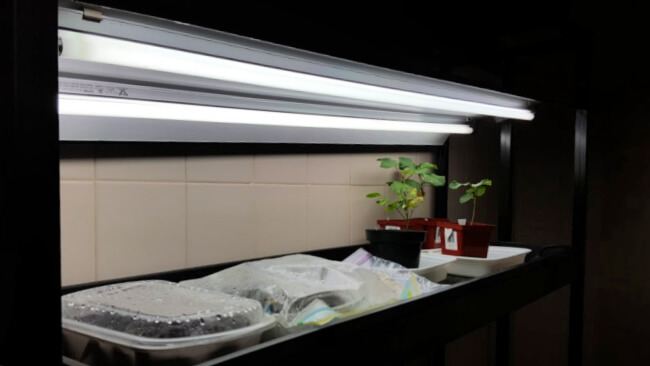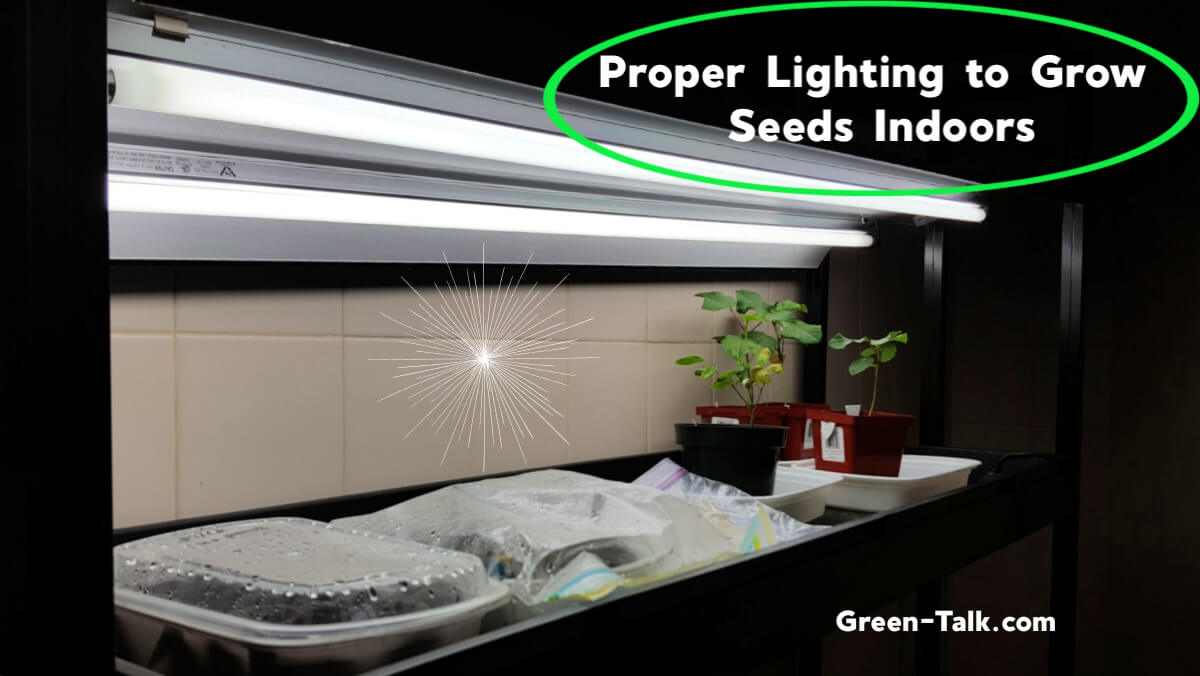If Tina Turner was a gardener, she would sing, “what’s light got to do with it?” Everything, my sunflowers. If you want to grow successful indoor vegetable and flower seedling, proper lighting is the key. Since this is the time to sow seeds indoors, let’s shed some illumination on proper lighting to grow seeds indoors.
Lighting to grow seeds indoors.
Before I begin, let’s dispel the window scenario right now. Use the window and your seedling will be lanky and spindly. The window ain’t going to cut it unless you have the optimal southern exposure window scenario. Most don’t, so “windowing” your seedlings is not an option.
Let’s get started on proper lighting to grow seeds indoors. We want you swimming in happy seedlings!
How many light bulbs do I need?
According to the University of Missouri Extension, vegetable plants need higher level of light intensity as compared to other plants.
“These plants need at least 1,000 foot-candles, or 20 watts per square foot of growing area, but should have higher intensities for best growth and flowering. Fixtures containing three to four fluorescent tubes are necessary for plants requiring high light intensity.”
Honestly, I couldn’t comprehend how many lights I needed using the 20 watts a square foot formula. I couldn’t find any state university information about a more simplified way to understand how many bulbs do you need per your growing space.
LED Grow Lights Depot has a handy chart but stresses wattage should be measured from the wall not what the manufacturer states on the package. In addition, they further state “wattage comparison” is generally not used when purchasing LEDs but it is a good start.
Bright Agrotech, a vertical farming company, does a really nice job in explaining indoor lighting dynamics. See it here.
When buying or making your own lighting fixtures, fluorescent bulbs should be 4 to 5 inches apart; whereas, LED lights should be 8 inches apart.
I have a three trier 2 light four foot T-5 6500 Kelvin lighting system that spans approximately four foot in length. I purchased it from Gardener’s Supply and it has lasted me over 10 years. So, it was expensive but an investment.
Light placement is key.
Additionally, I noticed newbie “seedlingers” tend to put their lights too far away from their plants. Their plants look spindly. Fluorescent lights should be placed 2 to 4 inches from the top of the plant.
As the plants grow, keep moving the lights. (Be sure to make sure you buy S chains or a pulley system so you can move the lights up and down.)
(Note, if the leaf edges start to look burned, your lights are too close to your plants.)
However, if you have those new swanky LED lights, then you want your lights to be 8 inches away from the plants.
How do I know if my plants have enough light?
Dr. Perry of the University of Vermont Extension suggests purchasing an inexpensive light meter to see how much light your plants are actually receiving. (If you want to purchase an inexpensive light meter, this particular model received good reviews on Amazon. Please read through all the questions and reviews before purchasing.)
Dr. Perry states:
“Light for growing is commonly measured in foot-candles—the amount of light given off by a candle one foot away. Two common T8 tubes placed six inches above plants will provide about 700 foot-candles. Reading lights, for comparison, often provide about 50 foot-candles.
Low light plants such as Chinese evergreen and Peace lily need between 50 and 250 foot-candles. Medium light plants such as African violets, begonias, dracaena, dumb cane, flame violet and seedlings need 250 to 1,000. High light plants such as most herbs and orchids need over 1,000 foot-candles. “
Just as a reference, outdoor light in a sunny area is 10,000 foot candles!
Note, the University of Georgia Cooperative Extension suggest to use your camera to read how much light your plants are receiving. Follow their guide.
Skip the shop lights
Plants respond best to full spectrum lighting. I have 6500 K T-5 full spectrum linear fluorescent bulbs. The “K” stands for Kelvin, which is the color temperature of the light emitted from the bulb. 6500 K is similar to outdoor daylight.
Dr. Leonard Perry of the University of Vermont Extension states,
“Quality refers to the actual wavelengths the lights provide to the plants. Light may look white to us, but is in reality made of many different wavelengths as seen in rainbows or when light strikes a prism. It is the red and blue parts that the plant uses for energy and growth, so these need to be provided by indoor lights. Terms you may see for light bulbs that provide these are “natural”, “full spectrum”, or “balanced.” They cost more than the usual incandescent bulbs that mainly provide red light to plants, or the cool white tubes that mainly provide blue light.”
Most shop lights are cool white lights which doesn’t provide the adequate lighting for seedlings. However, if you can’t find or can’t afford full spectrum bulbs, the University of Kentucky Cooperative Extension suggests one cool and one warm florescent bulb. As noted above, cool white fluorescent bulbs emit blue light whereas the warm white fluorescent bulbs emit red light.
As I mention in my earlier article, window sill lighting isn’t adequate. Your seedlings will be lanky and stretch for light.
Amount of hours the lights should remain on.

I generally turn my lights on for 14 to 16 hours. I keep mine on for 16 hours before the seeds germinate. Thereafter, I keep the lights on for 14 hours.
Unfortunately, I have left them on for 24 hours accidentally. What happened? Not much but I had to water the plants since they started to dry out. However, plants like some darkness especially as they get larger so don’t keep your lights on for 24 hours as a habit.
Buy a timer so you don’t forget to turn on and off the lights. You will thank me later.
Replacing the lights.
Fluorescent lights lose efficiency over time. If you notice that the ends of your fluorescent lights are getting a bit dark near the ends, it is time to replace them. Generally, T-5 lights should be replaced every 18 months to two years but it depends on usage.
Wishing you much success with lighting to grow your seeds indoors.
In case you are looking for an in-depth course on how to grow seeds indoors from choosing seeds to transplanting them in the garden, check out my course HERE.
Join the Conversation
Tell me what lighting system works for you.
Similar Posts:
